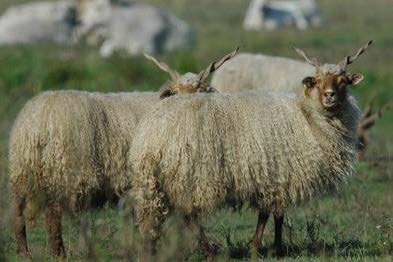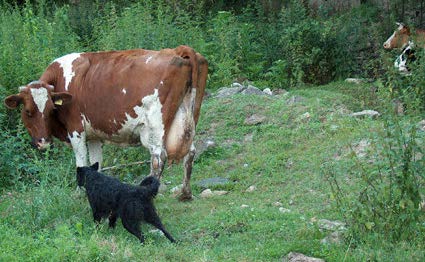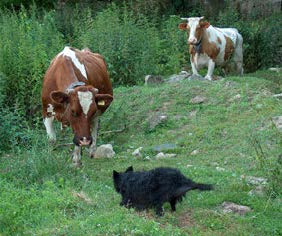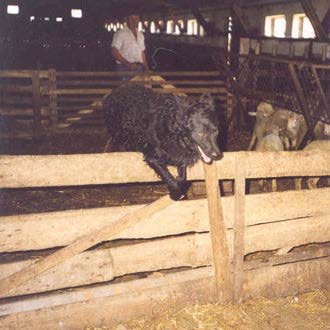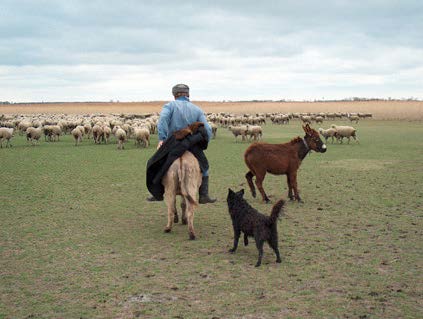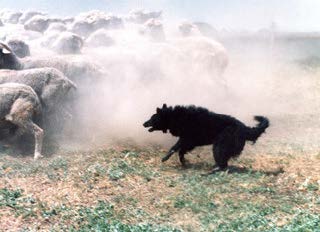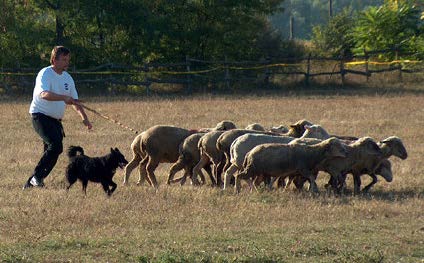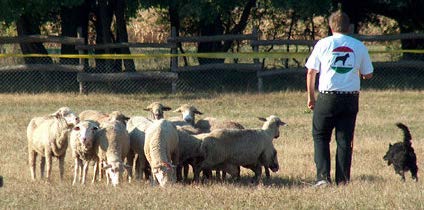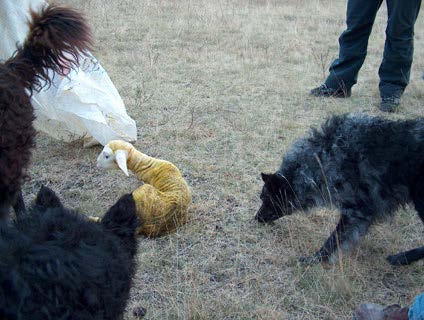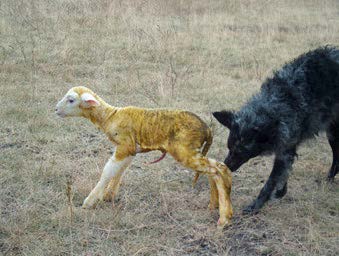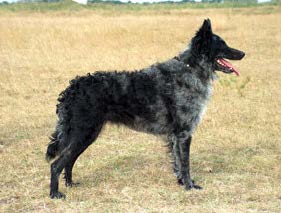The Mudi, Hungary’s “Driver Dog”
Written by: Dr. Péter Pongrácz and Celeste Spadavecchia
Written by: Dr. Péter Pongrácz and Celeste Spadavecchia
A Herding Breed, Past and Present
In the long gone past, almost all livestock, such as sheep, cattle, goats, horses and pigs, were kept outdoors year round. They formed smaller or bigger flocks and herds which grazed on the suitable pastures and if their owners sold them at an annual market, they were driven to that place on foot, not rarely from many hundred miles or more. This form of livestock keeping required basically two major activities from the herdsmen, moving and protecting the valuable animals.
A special type of working dog, the herding dog, was developed therefore as a help for these herdsmen quite long ago. We know these dogs from all over the Old World, including Asia, Africa and Europe.
More precisely as well, the need for two functionally and anatomically different types of herding dogs developed to serve the above mentioned major livestock handling functions. The lighter, quicker and extraordinarily keen-to-serve „true” herding dogs developed separately from the heavier, robust, incorruptible livestock guarding dogs. The task of the guarding dogs does not include the interaction with the livestock, they have to stay close to the flock and their job starts when some threatening agent appears on the scene. In contrast, the herding dogs have to have the so called herding instinct which, according to the scientific research of Coppinger and colleagues done in 1987, is an almost complete derivative of the wolves prey stalking, pursuing and catching behavioral sequence, without the end part, the actual catch, kill and devour action.
Through the cultural history of animal keeping, an amazingly rich variety of herding dog types, today known as breeds, were developed. Some of them are old, but many of them have more recent origins. Even in the New World (the American and Australian continents) people have developed new herding breeds.
Hungary has always been famous for its animal breeding, which is not a surprise, if we think about the Hungarians original occupation as a mostly animal herding nation from the East, but also the historical Hungary’s excellent environmental circumstances for keeping large flocks of grazing animals. As Hungary has original cattle and sheep breeds from the age of the Conquest of the Carpathian Basin more than 1100 years ago, such as the Grey Cow and the Racka Sheep, it is also very likely that some of the Hungarian dog breeds have a long history as well.
Sadly however as the country’s history and development was almost torn apart by the many hundred years of Turkish and Austrian occupations between the 16th and 19th century, we know relatively little about the exact origins of the Hungarian dog breeds.
The recent theories about the formation of these breeds are still more strongly based on the deductive thinking derived from the actual outlook of the breeds, than on the few original documents and comparative history of the related breeds around Hungary. A nice example of this is the supposed relationship between the three medium sized Hungarian herding dogs, the Mudi, Puli and Pumi. As the first herding breed which wrote a breed standard in the first decades of the 20th century was the Puli, the other two younger breeds, the dog experts tried to describe as derivatives of the „ancient” Puli. This type of reasoning is based on the erroneous belief that the difference between the actual dates when the three breeds were described (a couple decades as a maximum) should mean the same chronological order in the appearance of these breeds in history as well.
Today more and more debate goes on about the actual relationship between the Hungarian herding breeds, but this article has a different aim, and that is to talk about how shepherds used past and presently, the Mudi with livestock.
Developing Type
Hungary’s natural circumstances for livestock keeping were and are quite different than those in Western Europe and the British isles. Here the grazing fields are mostly flat and almost endless in comparison to the western countries hillier pastures. Accordingly with large free areas, the original sheep and cattle flocks were also large, and mostly the sheep flocks are still quite numerous today, with 500-1000 animals in one flock. This fact, coupled with the harsh climate (hot summer, cold winter) required tough and athletic herding dogs. A good example for this is the Mudi. The dog’s appearance and outer qualities serve the strength, speed and low maintenance requirements. The size of this breed is a good compromise to be able to herd larger and smaller livestock, although it is primarily a sheepdog. The Mudi is large and strong enough for groundcovering speed beside great flocks of sheep, or for motivating cattle, but it is small enough to be maintained on small quantities of food, which was essential in poorer areas. The breed’s special feature is the quite unique coat type. The Mudi’s fur is not wooly (which is a big difference from the Puli and Pumi), medium long (never short), strongly wavy or slightly curly and of medium texture which is rather soft. This type of fur is excellent against any burry plant seeds and easily repels dirt and snow. Because the Mudi sheds its dead fur, shepherds did not need to cut down the fur annually as they did with the other sheepdogs. Having a lighter summer coat and a heavier winter coat, the Mudi is truly an all season herding dog which could hold up under harsh climatic conditions.
Mudis are still being used for herding not only sheep, but cattle and even pigs. However pigs these days are kept almost exclusively in sheds and enclosures and only the cattle and sheep remain as herdable subjects for the dogs.
The recent theories about the formation of these breeds are still more strongly based on the deductive thinking derived from the actual outlook of the breeds, than on the few original documents and comparative history of the related breeds around Hungary. A nice example of this is the supposed relationship between the three medium sized Hungarian herding dogs, the Mudi, Puli and Pumi. As the first herding breed which wrote a breed standard in the first decades of the 20th century was the Puli, the other two younger breeds, the dog experts tried to describe as derivatives of the „ancient” Puli. This type of reasoning is based on the erroneous belief that the difference between the actual dates when the three breeds were described (a couple decades as a maximum) should mean the same chronological order in the appearance of these breeds in history as well.
Today more and more debate goes on about the actual relationship between the Hungarian herding breeds, but this article has a different aim, and that is to talk about how shepherds used past and presently, the Mudi with livestock.
Developing Type
Hungary’s natural circumstances for livestock keeping were and are quite different than those in Western Europe and the British isles. Here the grazing fields are mostly flat and almost endless in comparison to the western countries hillier pastures. Accordingly with large free areas, the original sheep and cattle flocks were also large, and mostly the sheep flocks are still quite numerous today, with 500-1000 animals in one flock. This fact, coupled with the harsh climate (hot summer, cold winter) required tough and athletic herding dogs. A good example for this is the Mudi. The dog’s appearance and outer qualities serve the strength, speed and low maintenance requirements. The size of this breed is a good compromise to be able to herd larger and smaller livestock, although it is primarily a sheepdog. The Mudi is large and strong enough for groundcovering speed beside great flocks of sheep, or for motivating cattle, but it is small enough to be maintained on small quantities of food, which was essential in poorer areas. The breed’s special feature is the quite unique coat type. The Mudi’s fur is not wooly (which is a big difference from the Puli and Pumi), medium long (never short), strongly wavy or slightly curly and of medium texture which is rather soft. This type of fur is excellent against any burry plant seeds and easily repels dirt and snow. Because the Mudi sheds its dead fur, shepherds did not need to cut down the fur annually as they did with the other sheepdogs. Having a lighter summer coat and a heavier winter coat, the Mudi is truly an all season herding dog which could hold up under harsh climatic conditions.
Mudis are still being used for herding not only sheep, but cattle and even pigs. However pigs these days are kept almost exclusively in sheds and enclosures and only the cattle and sheep remain as herdable subjects for the dogs.
There are significant and very interesting differences in herding of these two types of livestock. These differences originate themselves from the fact that sheep and cattle possess different temperaments, strength and behavioral habits. If we consider herding as a type of predator activity for a moment, then we can understand that predators also use different techniques to hunt different quarries. Similarly, a sheep flock needs a differently behaving and trained herding dog than a herd of cattle does.
Tough Enough
The major difference between livestock lies in the size, temperament and behavior. Cattle are large animals and much depends on the breed, sex and age, but they can be mean and hostile. If the pasture contains bushy areas, cattle like to hide within the thickets, especially cows with calves. Cattle also lack the very strong flock instinct of the sheep, therefore cattle herding requires more one-on-one interaction by the dog with particular individuals than moving a whole flock together.
Tough Enough
The major difference between livestock lies in the size, temperament and behavior. Cattle are large animals and much depends on the breed, sex and age, but they can be mean and hostile. If the pasture contains bushy areas, cattle like to hide within the thickets, especially cows with calves. Cattle also lack the very strong flock instinct of the sheep, therefore cattle herding requires more one-on-one interaction by the dog with particular individuals than moving a whole flock together.
Cattle herding Mudi’s have multiple tasks such as finding and moving individual cows from the bushes (usually thorny plants, like wild rose, or blackberry), moving grazing cattle from one area to another and keeping the cattle out of a particular area. Occasionally cattle have to be separated and penned as well. Generally the following rules apply when working with cattle, the bulls are harder to herd than cows, younger animals are easier to herd than adults, beef cows are wilder than dairy cows and single cows are less dangerous than those with calves. On average, cattle are more likely to start a fight with the dog and harder to start or stop than sheep. One reason is obvious if we think about the size difference between a cow and a Mudi. Therefore cattle herders prefer to use bigger dogs, harder dogs and more dogs beside their cattle herds.
A cattle herding Mudi has to have not only herding instinct, but the desire and ability to bite the cow. As the shepherds tell it, without physical contact many of the cows and bulls will ignore the dogs, in vain, they bark and chase after them. Moreover, cattle tend to fight and even destroy dogs. Sooner or later the cattle should learn that the dogs are dangerous and painful enemies and from that point the herding job will be easier, because the „trained” cattle will obey the dogs more easily. Accordingly, the training of the cattle herding dogs mostly includes the awakening of the dog’s gripping or biting instinct, besides the tricks of herding and following the shepherd’s commands.
We differentiate three types of cattle herding Mudis, those who drive from behind (at the tail and heels of the cows), those who drive from the front (at the nose of the cattle); and those who drive from both directions. These herding styles are seemingly inborn, which means that they are not taught, but the shepherd figures out after a time, which group his new dog belongs in. Obviously, rear driving dogs are especially useful for starting the cattle, while front driving dogs can effectively stop, or turn them. This, and the difficulty of working with big and aggressive livestock, makes it necessary to use at least 2 to 3 dogs for even a smaller cattle herd. When a cow or bull decides to fight, one dog is not usually enough to make it change its opinion. Using more than one dog makes it harder for the cow to perform a dangerous attack on any dog individually, because its focus will be scattered.
A cattle herding Mudi has to have not only herding instinct, but the desire and ability to bite the cow. As the shepherds tell it, without physical contact many of the cows and bulls will ignore the dogs, in vain, they bark and chase after them. Moreover, cattle tend to fight and even destroy dogs. Sooner or later the cattle should learn that the dogs are dangerous and painful enemies and from that point the herding job will be easier, because the „trained” cattle will obey the dogs more easily. Accordingly, the training of the cattle herding dogs mostly includes the awakening of the dog’s gripping or biting instinct, besides the tricks of herding and following the shepherd’s commands.
We differentiate three types of cattle herding Mudis, those who drive from behind (at the tail and heels of the cows), those who drive from the front (at the nose of the cattle); and those who drive from both directions. These herding styles are seemingly inborn, which means that they are not taught, but the shepherd figures out after a time, which group his new dog belongs in. Obviously, rear driving dogs are especially useful for starting the cattle, while front driving dogs can effectively stop, or turn them. This, and the difficulty of working with big and aggressive livestock, makes it necessary to use at least 2 to 3 dogs for even a smaller cattle herd. When a cow or bull decides to fight, one dog is not usually enough to make it change its opinion. Using more than one dog makes it harder for the cow to perform a dangerous attack on any dog individually, because its focus will be scattered.
In spite of the necessity of courage in the cattle herding Mudis, herdsmen do not like if dogs make serious wounds on the livestock, especially on the tail tips and udders. Rear driving Mudis tend to hang onto the long hair at the end of the tail and pull it out. If the tail of the cow loses the long hair, the animal loses its ability to fight against the flies and other blood sucking insects. Shepherds use an interesting technique to discourage young Mudis from gripping cattle tails. When the dogs are introduced to the livestock, usually in spring or early summer, the shepherd cuts off the tail hair of the cattle, therefore the young herding student will not learn to catch the tempting end. When the hair will grow out again, the dog has already learned how to attack the heels of the cows and will not pay attention to the tail.
Cattle herding is more and more sporadic in Hungary in these recent times, as cattle keeping becomes more barn and pen based, the large cattle herds are disappearing from the open pastures. Accordingly, cattle herding is not something that working Mudis regularly do throughout today’s Hungary. It is rather an occasional sight here and there that is dependent on the actual cattle owner’s habits. In comparison to this, sheep herding is still a major occupation for the Mudi in Hungary and hopefully it will be in the future too. The sheep are perhaps the last livestock species which is still kept on the grazing fields more than in closed pens or barns. Sheep are sturdy and not so picky eaters and most of Hungary’s grazing areas are excellent for sheep, being quite dry and covered with short grass. It is notable to mention that flocks of sheep are also used for keeping the grass short on the smaller airfields that are used by sport and agricultural planes, and some of the national parks also use sheep flocks to keep the meadows in the condition which is considered „original” to those areas. Sheepdogs, which include the Mudi, are the most widely used breed group that have a permanent job in Hungary today.
The Soft Side
All the shepherds I have met and talked with told the same thing, „without a dog they could not work, as the single dog does as much work as five or more people with the sheep”. The Mudis have multiple tasks with the livestock. At the barns, they help to drive out the sheep from the enclosures or sheds. They help to separate different age classes, such as the newborn lambs which remain in the barn from the mother sheep that go out to graze, the dog moves the adult sheep through the barn door while the shepherd keeps the newborn lambs inside. Also in the barns the dogs help to push the sheep through narrow sections, such as when the sheep are being bathed against parasites, they have to be forced into a smaller pond filled with water in which medicine was dissolved. The sheep which are accustomed to being moved by dogs are quite easy to handle, as they don’t fight back and don’t panic easily, but the work with the larger flock, especially when the sheep don’t want to do something, is quite hard. As the major characteristic of sheep is the flocking instinct, a dense flock is much more difficult to move from a narrower part of the pen if the dog is driving on only one end of the flock. The sheep standing at the front won’t move if the ones at the end are being driven forward. Therefore the work in confined areas requires good cooperation between the shepherd and the dog, because they have to work on different ends of the flock and they have to do different things. While the dog remains at the rear end of the flock and barks at the sheep, sometimes even nipping them, the shepherd goes to move the sheep at the front.
Cattle herding is more and more sporadic in Hungary in these recent times, as cattle keeping becomes more barn and pen based, the large cattle herds are disappearing from the open pastures. Accordingly, cattle herding is not something that working Mudis regularly do throughout today’s Hungary. It is rather an occasional sight here and there that is dependent on the actual cattle owner’s habits. In comparison to this, sheep herding is still a major occupation for the Mudi in Hungary and hopefully it will be in the future too. The sheep are perhaps the last livestock species which is still kept on the grazing fields more than in closed pens or barns. Sheep are sturdy and not so picky eaters and most of Hungary’s grazing areas are excellent for sheep, being quite dry and covered with short grass. It is notable to mention that flocks of sheep are also used for keeping the grass short on the smaller airfields that are used by sport and agricultural planes, and some of the national parks also use sheep flocks to keep the meadows in the condition which is considered „original” to those areas. Sheepdogs, which include the Mudi, are the most widely used breed group that have a permanent job in Hungary today.
The Soft Side
All the shepherds I have met and talked with told the same thing, „without a dog they could not work, as the single dog does as much work as five or more people with the sheep”. The Mudis have multiple tasks with the livestock. At the barns, they help to drive out the sheep from the enclosures or sheds. They help to separate different age classes, such as the newborn lambs which remain in the barn from the mother sheep that go out to graze, the dog moves the adult sheep through the barn door while the shepherd keeps the newborn lambs inside. Also in the barns the dogs help to push the sheep through narrow sections, such as when the sheep are being bathed against parasites, they have to be forced into a smaller pond filled with water in which medicine was dissolved. The sheep which are accustomed to being moved by dogs are quite easy to handle, as they don’t fight back and don’t panic easily, but the work with the larger flock, especially when the sheep don’t want to do something, is quite hard. As the major characteristic of sheep is the flocking instinct, a dense flock is much more difficult to move from a narrower part of the pen if the dog is driving on only one end of the flock. The sheep standing at the front won’t move if the ones at the end are being driven forward. Therefore the work in confined areas requires good cooperation between the shepherd and the dog, because they have to work on different ends of the flock and they have to do different things. While the dog remains at the rear end of the flock and barks at the sheep, sometimes even nipping them, the shepherd goes to move the sheep at the front.
Out on the open fields, the task of the dog is dependent on what kind of pasture is available. If there is nothing to be avoided (crops, roads, gardens) the work is simpler. If the sheep need to be kept away from particular areas, the sheep herding Mudi should have more refined skills to conduct the animals and obey his master’s commands. Hungarian sheep flocks are large (many hundreds of sheep usually), therefore the shepherds need very strong, athletic dogs. Although Hungarian shepherds respect the skills of the Border Collies when they see them on sport competitions, their opinion is that Border Collies would not be tough enough to work constantly with big flocks on the open pastures. Another reason why the Mudi (or another Hungarian sheep herding breed) is more suitable for our shepherds is because they prefer a less highly temperamented dog than many of the western herding breeds.
The herding style of the Hungarian sheepdogs is dramatically different from the Border Collie style which is well known in the western world. The major differences being that Mudi’s bark during their work, and they never herd with eye or with the front down, back up stalking posture. The usual arrangement of the flock, dog and shepherd while moving the sheep from place to place is that of: shepherd, dog, sheep, with the sheep in the front and the dog behind the flock taking commands from the shepherd on which way to turn or move the sheep.
Barking is needed for the Mudi’s work because the scattered huge sheep flock can be notified sooner that the dog is coming than if the dog would run without barking. However, shepherds like the moderately barking dogs, who „only bark when it is needed”. A constantly barking dog makes the livestock unnecessarily nervous. In an ideal case, the Mudi starts to bark from the half way point while approaching the sheep, and continues the barking during the close work beside the flock. In the eyes of the Hungarian shepherds the hardest task for the sheepdog is to work with the sheep from large distances. It means that a really good Mudi should be able to go for the sheep on command to a distance as far away as 400-600 meters (near 600 yards). It is required when the flock should be stopped, collected, turned to the left or right, or driven back to the shepherd. Of course, the shepherd gives commands to the Mudi while it works, which are the combinations of verbal commands, hand signals (enhanced by the shepherd’s stick, or his hat) and sometimes whistles. Commanding a dog from many hundred meters is not easy, especially if the wind blows towards the shepherd, and/or the bells on the sheep make it difficult to hear the commands. Therefore the visual signals are important too, and for getting these signals, the dog has to come from beside the flock time by time to look at the shepherd and wait the next command. As shepherds say, not every dog is suitable for long distance work, therefore a really good one has a high value. There is often a major (verbal) competition among the shepherds who can send his dog to the sheep from the biggest distance.
The training of the sheepdog starts at quite an early age, usually when the puppies are 3-5 months old. During this time the existence of the herding instinct should be obvious in the Mudi, which expresses itself in the attentiveness toward the sheep, and the willingness to chase and bark at them. Training is hard work for the shepherd as it should be tailored to the particular novice and should be executed by the shepherd himself every day, for at least a few months. Usually only one Mudi works at the same time with a flock (even beside the large, 800-1000 sheep flocks). Therefore shepherds don’t like to train their new dogs together with an experienced one, because in their opinion, the new dog will not want to work alone, and during herding the two dogs will pay attention mostly to each other, being competitors somehow. So the shepherd goes by himself with the new dog, and at first during close distance work trains it, by running to the given direction together with the dog, showing him what the given commands mean. A Mudi has the natural instinct to circle around the sheep, it is the base from where the more sophisticated skills are developed. It is essential that the Mudi should come back immediately from any point of the circle, which makes it possible to drive the sheep into the required direction. Directions, like right or left, are taught as a combination of verbal and hand commands. However, every dog has an „inherited” side, which means that from a larger distance they will approach the flock always from the same direction. The shepherds know well which is the easier task to do with their given dog, turn the flock to left, or turn it to the right.
Working Mudis have a great value among the shepherds. The Mudi is considered a particularly tough and sturdy breed which is able to work all day. The schedule for a day usually consists from two grazing periods, morning and afternoon, with a siesta in the barn at noon. If the dog is not enough tough, the shepherd needs two dogs, one for the morning and one for the afternoon. Mudis are usually able to work during both periods. Shepherds tell that if „you see somewhere a really good sheepdog you should try to buy it immediately, not thinking about the price”. It shows an interesting aspect of the management of the sheepdogs. Although they get personal training and they are well known in regards to their loyalty and owner centeredness, it is not a rare thing that shepherds actually trade them as adults, or borrow them for a while. According to the stories I have heard, these dogs work well with their new masters too. Working Mudis are exceptionally obedient, with a sense of humbleness towards the owner. They are reserved but touchable by strangers in the presence of their master. Shepherds like and somehow appreciate their dogs, but also provide them with a hard life as they themselves live. If the dog is too rough with sheep, they file down the fangs. Misbehaving, or unable to work dogs, are usually not kept alive.
There is no trading amongst shepherds cattle herding dogs for sheep herding dogs, because those dogs who were taught to drive cattle, can sometimes harm seriously the sheep. These dogs, if they are used for sheep later, which rarely occurs, are muzzled during herding.
Looks Matter
Another interesting question is the tail docking. Seemingly shepherds do not follow some „common agreement” in this question around Hungary. Some of them dock the tail, some never do. The reasons for docking are various. I met with shepherds who dock „because my grandfather did it too”, while others do it „because the tail of the dog would be constantly tangled with the burry seeds of the weeds”.
Contrary to the common belief that sheepdogs were selected only for working qualities, many shepherds have a firm imagination of what makes a dog visually appealing. If they can, they choose dogs which fit to these „rural standards”. Among the most important beauty rules I have heard, were ones about how the correct tail should look („over the back, like a sickle”), how the dog should hold the neck and the head („upright, like a jackal”), what kind of a color the dog should be („all the colors are good, if they are solid, no white patches, the best is the beetle black”), even, how the dog’s fur looks the best („I trim it resembling to a lion, that is long at the neck, short on the back”) (!!!).
Looks Matter
Another interesting question is the tail docking. Seemingly shepherds do not follow some „common agreement” in this question around Hungary. Some of them dock the tail, some never do. The reasons for docking are various. I met with shepherds who dock „because my grandfather did it too”, while others do it „because the tail of the dog would be constantly tangled with the burry seeds of the weeds”.
Contrary to the common belief that sheepdogs were selected only for working qualities, many shepherds have a firm imagination of what makes a dog visually appealing. If they can, they choose dogs which fit to these „rural standards”. Among the most important beauty rules I have heard, were ones about how the correct tail should look („over the back, like a sickle”), how the dog should hold the neck and the head („upright, like a jackal”), what kind of a color the dog should be („all the colors are good, if they are solid, no white patches, the best is the beetle black”), even, how the dog’s fur looks the best („I trim it resembling to a lion, that is long at the neck, short on the back”) (!!!).
A Herding Breed for the Future
The Mudi as a breed was formed surely for fulfilling the task of an incredibly hardworking, intelligent, tough sheepdog, with alot of guarding intuition and considerable hunting skills. In our modern world it is a miracle that we still have such a mentally and physically unchanged working breed, which was not spoiled or altered by the so called „show breeding”. If we would like to have this dog for our future service and enjoyment, we should understand that no other activity and selection can maintain the good characteristics of the Mudi, than keeping it an active working herding dog breed. We should remember that the circumstances which resulted in this wonderful breed are quickly fading, as free ranging flocks and shepherds themselves are a „breed” near to extinction. If we let our Mudis’ herding abilities deteriorate and fade, in vain we will wish them to remain as useful and pleasant sports dogs and companions, as very few realize that without this natural selected ability, this „new future” purpose will be harder to achieve as well. Shepherds tell that „every man has only one really good dog during his lifetime, no matter how many dogs he had as a sum”. Let us not forget, that to recreate another naturally selected breed like the Mudi in today’s world, could probably never happen again. Modern Mudi enthusiasts should be the sentinels of this breed to maintain the original working abilities as a high priority, so that truly every of one us can find his or her life’s „good dog” in the future, too.
The Mudi as a breed was formed surely for fulfilling the task of an incredibly hardworking, intelligent, tough sheepdog, with alot of guarding intuition and considerable hunting skills. In our modern world it is a miracle that we still have such a mentally and physically unchanged working breed, which was not spoiled or altered by the so called „show breeding”. If we would like to have this dog for our future service and enjoyment, we should understand that no other activity and selection can maintain the good characteristics of the Mudi, than keeping it an active working herding dog breed. We should remember that the circumstances which resulted in this wonderful breed are quickly fading, as free ranging flocks and shepherds themselves are a „breed” near to extinction. If we let our Mudis’ herding abilities deteriorate and fade, in vain we will wish them to remain as useful and pleasant sports dogs and companions, as very few realize that without this natural selected ability, this „new future” purpose will be harder to achieve as well. Shepherds tell that „every man has only one really good dog during his lifetime, no matter how many dogs he had as a sum”. Let us not forget, that to recreate another naturally selected breed like the Mudi in today’s world, could probably never happen again. Modern Mudi enthusiasts should be the sentinels of this breed to maintain the original working abilities as a high priority, so that truly every of one us can find his or her life’s „good dog” in the future, too.
Celeste Spadavecchia and Dr. Péter Pongrácz (the authors) and their Mudis, Fecske and Angel.


